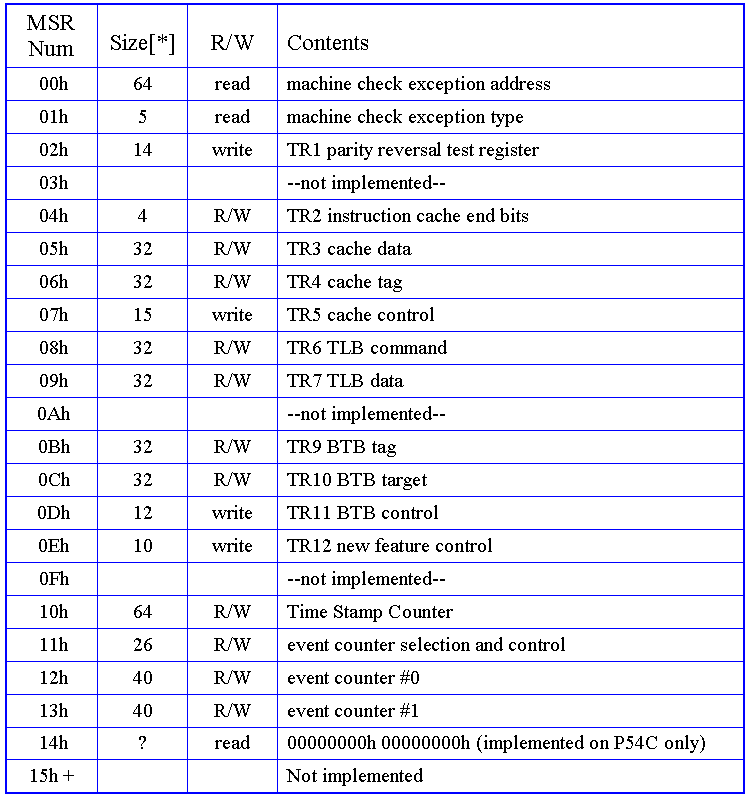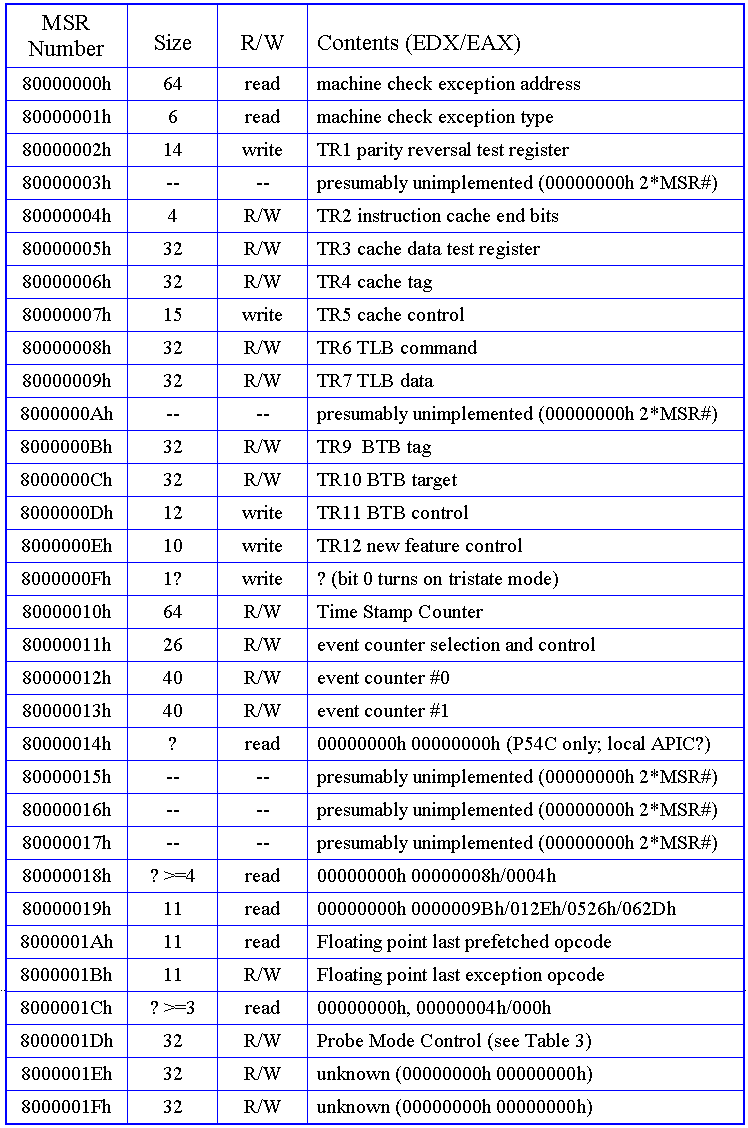
The use of a signed, rather than an unsigned, comparison in the microcode for the Intel Pentium(tm) processor's RDMSR and WRMSR instructions produces behavior which allows one to infer additional details about those instructions' microcode, as well as providing access to additional model-specific registers which would normally be blocked by the microcode.
The October 1, 1995 release of Christian Ludloff's 4P package [1] of undocumented information about Intel (and compatible) processors mentions the availability of model-specific registers in the range 80000000h to FFFFFFFFh on Intel's P54C Pentium processors. This paper investigates those registers and presents some thoughts about what may be inferred about the Pentium's internal architecture from those registers.
The RDMSR and WRMSR instructions provide access to the model-specific register specified in register ECX. These instructions are privileged, and thus available only in true real mode or Ring 0 protected-mode code. Many memory managers, such as Microsoft's EMM386 or Quarterdeck's QEMM v7.0+, will execute the instructions on the application's behalf when they are the reason for a General Protection Fault (Exception #13).
A Pentium will accept model-specific registers numbers from 00h to 13h or 14h (depending on model, and with a few specific exceptions; see Table 1). This is more-or-less documented by Intel in the Pentium Processor User's Manual [2]. However, Pentium processors produced to date[*] will also accept any MSR number from 80000000h to FFFFFFFFh, inclusive, even though it signals an exception on MSR numbers 00000015h to 7FFFFFFFh. Clearly, there is an internal range check, but rather than an unsigned comparison, a signed comparison is performed. In other words, the microcode contains instructions equivalent to
CMP ECX, 00000014h
JG bad_index
instead of
CMP ECX, 00000014h
JA bad_index
This improper comparison is present in the microcode for both RDMSR and WRMSR instructions, as it is possible to set MSRs above 80000000h as well as read them.
[*] And likely any Intel Pentium processors produced in the future, since the Pentium errata document lists this erratum (number 33) as having no fix. This supports the conjecture that access to the high MSRs is a deliberate back door rather than an unintended bug.
An examination of the values read from MSRs 80000000h and up immediately reveals that the values repeat after every 32 MSRs, so clearly only the low five bits of the MSR number are actually significant. Further, many of the entries happen to have as their low 32 bits a value exactly twice the MSR number; it will shortly be seen that these MSRs are write-only, and that this behavior reveals something of the Pentium internals.
Since the high MSRs repeat every 32 entries, only the first repetition will be referenced in this paper. It should be understood that 80000000h also refers to 80000020h, 0000040h, ... , FFFFFFE0h (and similarly for the other registers 80000001h through 8000001Fh). Listing 1 contains the source code for a small (114 bytes) program to dump all 32 unique high MSRs; this program was used extensively during the investigations described in this paper.
A closer look at the high MSRs, along with a bit of experimentation, reveals that 80000000h through 80000014h exactly duplicate the MSRs 00h through 14h (except for 03h, 0Ah, and 0Fh, which generate exceptions where their high counterparts do not). Because the high-numbered aliases for MSRs 03h, 0Ah, and 0Fh do not generate exceptions, the microcode clearly includes specific tests for those three values in order to generate exceptions, rather than including some form of "valid" bit for each MSR. Detailed bit assignments for MSRs 00h through 13h will not be given here, as they have already been documented elsewhere (e.g. [1][5][7]).
It should be possible to determine the ordering of the ECX checks by performing exact cycle timings on RDMSR instructions with different values in ECX. Preliminary experiments have shown that RDMSR on valid MSR numbers takes 22 clock cycles except on MSRs containing more than 32 valid bits; those take 26 clock cycles (note that the official timing is 20-24 clocks). The author conjectures that 0015h <= ECX <= 7FFFFFFFh will execute in at most 18 clock cycles, and the three special cases will take three intermediate times in some order. The difficult part of this measurement will be compensating for the time taken by the Exception 13 handler (the initial attempt to measure the exception-causing cases yielded negative execution times!)..
What about MSRs 80000015h through 8000001Fh, which have not yet been addressed? While the first three (80000015h to 80000017h) seem to be unimplemented -- they appear as write-only registers, and writes to them have no discernable effect -- the remaining eight MSRs are indeed implemented. Further, at least one bit of the normally-inaccessible
MSR 0Fh is active. As shown in Table 2, MSRs 80000018h-8000001Ah and 8000001Ch are read-only, while MSRs 8000001Bh and 8000001Dh-8000001Fh are read/write.
MSR 8000000Fh is a write-only register corresponding to the normally blocked MSR 0Fh. Only bit 0 has any obvious effect, instantly locking the author's system when set (no effect when cleared). When observed with a logic analyzer, all bus activity stops the instant this bit is set with WRMSR, apparently because the CPU has been completely halted -- asserting SMI# (the System Management Interrupt line, which has a priority even higher than NMI) has no effect on this condition [3]. This bit apparently places the CPU into tristate mode (in which the bus is left floating); to date, the only method found to leave this mode is a system reset. Attempts to resume normal execution by immediately following the WRMSR setting the tri-state bit with another clearing it were unsuccessful, even with both WRMSR instructions in the same cache line (i.e. no memory accesses required).
The purpose of MSR 80000018h is as yet undetermined, but it is related to memory management. This MSR contains 00000004h immediately after a cold start, but switches to 00000008h as soon as paging is enabled [6] (usually by a memory manager such as EMM386 or QEMM-386). It remains at 00000008h after a QEMM QuickBoot (which does not completely reset the machine's state) -- even when rebooting without a memory manager.
MSRs 80000019h through 8000001Bh provide access to the floating point unit's instruction stream. Register 80000019h contains the most-recently prefetched floating-point opcode, while register 8000001Ah contains the most recently executed non-control opcode (i.e. instructions such as FSTENV or FRSTOR do not change the MSR).
Register 8000001Bh contains the opcode of the last non-control instruction encountering an exception, and is part of the environment accessed through the FSTENV, FLDENV, FSAVE, and FRSTOR instructions. Any value written to this MSR will appear in the opcode field of an immediately following FSTENV or FSAVE environment image. All three registers consist of eleven bits, the high three bits of which are the low three bits of the instruction's opcode, and the low eight bits of which are the second byte of the floating-point instruction (there is an ambiguity because FWAIT is stored in MSR 80000019h as 09Bh, as is the variant of FCOMP coded by D8h-9Bh). The most-recently prefetched instruction need not be the same as the most recently executed instruction, since the most recent instruction may have been a control instruction (not stored in MSRs 8000001Ah or 8000001Bh) or the processor may have branched to another location before reaching the prefetched instruction.
MSR 8000001Ch normally contains the value 00000004h, though the value 00000000h was seen in one instance, and the value 00000008h was reported on a 100 MHz Pentium. Its purpose remains unknown.
MSR 8000001Dh proves to be the Probe Mode Control Register [3] (see Table 3), which is ordinarily only visible from an In-Circuit Emulator.
MSRs 8000001Eh and 8000001Fh have not produced any effects in testing, though all of the low 32 bits of each are settable (both registers initially contain all zeros). These MSRs may be nothing more than scratch storage. They are known not to be related to the FPU's environment, the more common floating-point instructinos, CMPXCHG8B, SHLD, or BOUND.
Given that unreadable MSRs always return twice their own register number
in their low 32 bits, it seems clear that the Pentium treats the MSRs as
an array of sixty-four 32-bit entries internally. Why this doubled value
should appear in the programmer-visible registers is less clear.
Three possibilities present themselves:
The flaw in the argument for the first possibility is that EDX is always zero and EAX even rather than odd. If MSR entries are only 32 bits (as implied by the doubling of the MSR number), then two data transfers would be required, one addressed at 2*ECX for EAX and one at 2*ECX+1 for EDX. In support of this possibility, the Pentium's probe mode interface is reported to make two accesses in the process of fetching a complete MSR, and Christian Ludloff reports that MSRs 80000002h and 8000000Eh (plus aliases) force some of their bits to zero on his machine (which does not occur on the author's machine).
The second possibility seems somewhat contrived -- why load a programmer-visible register with 2*ECX when the same effect could be had by rearranging the data lines going to the MSR entry storage or using one of the already-existing temporary registers in the processor?
The third alternative would be difficult to prove or disprove - Robert Collins suggested that it has the added side-effect of keeping everyone wondering.
The apparently deliberate use of an incorrect comparison in the Intel Pentium microcode provides access to additional model-specific registers, some of which allow use of internal registers or data storage which are not normally accessible, or accessible only from an In-Circuit Emulator. Further, the contents read from write-only model-specific registers imply that MSRs are stored as an array of 32-bit values internally, though they are presented to the programmer as 64-bit values.

[*] The 'size' column indicates the highest bit which may be set or which is valid on read-only registers. For readable registers, bits numbered 'size' through 63 are always 0.


Download source code for MSR.ASM:
http://www.rcollins.org/ftp/source/p5msr/msr.asm